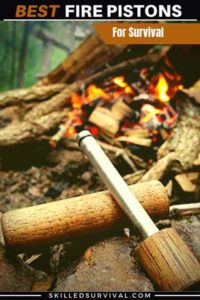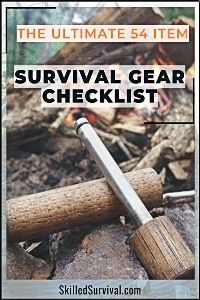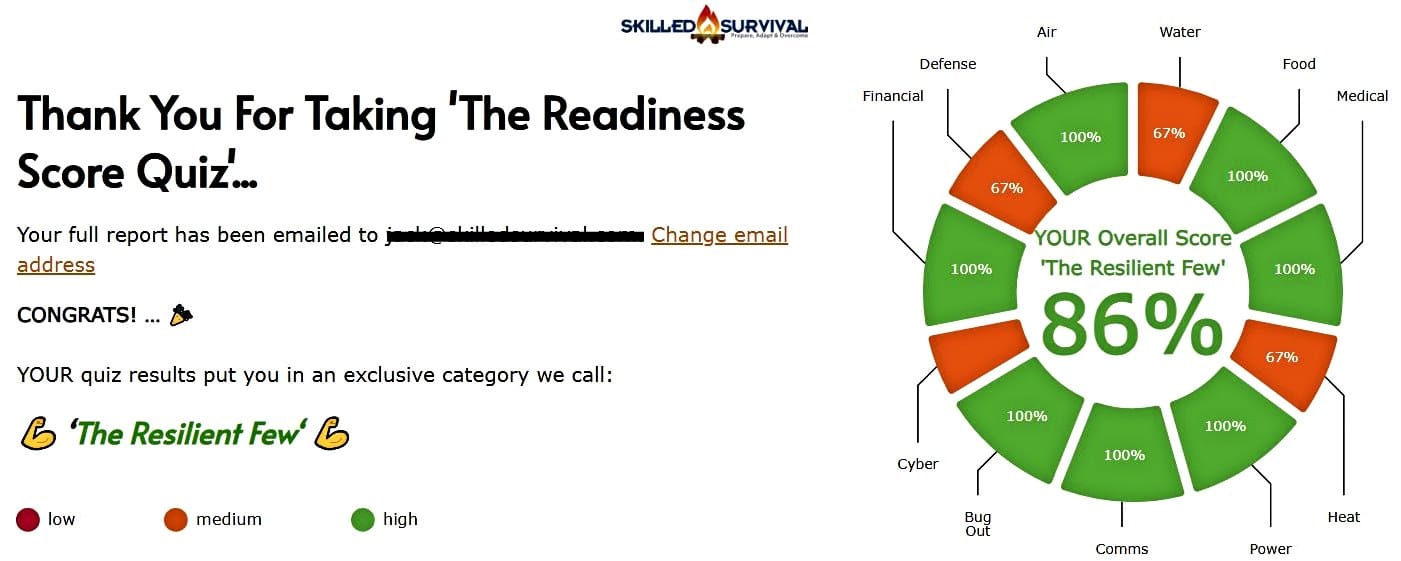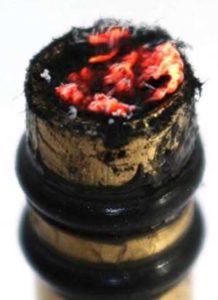
A Complete Guide To Researching & Using A Fire Piston
Because when it comes to survival, making fire is one of the most important.
But some fire starting devices are better than others.
And fire pistons are an excellent back up option!
But only IF you own a good one and know how to use it…
TOPICS IN THIS GUIDE… ↓(click to jump)
- Best Fire Pistons On The Market
- What’s A Compression Fire?
- Science: How Fire Pistons Work
- How To Use A Fire Piston
- Best Tinder’s To Use With It
- How To Make A Your Own
- Why You Should Own One
Best Fire Pistons For Sale Today
Let’s now look at a few of the best fire pistons on the market today.
I want to show you various types, styles and prices to choose from:
This is a very nice-looking model with a wooden handle that saves your hands. Especially when compared with the knurled grips of other options.
The aluminum inner cylinder and piston are well constructed and should stand up to years of use.
Plus, the hickory outside makes this one a great survival gift to show off to your friends.
↓ Hickory Piston Review
↓ PSKOOK Piston Fire Starter
The Scout Piston is manufactured from a space-age polymer and features an aluminum piston shaft.
It also comes with some char-cloth and a spare O ring.
Finally, it has a LIFETIME WARRANTY.
They will repair or replace any product that fails to perform for any reason.
↓ Wilderness Solutions FireStarter Piston
This kit comes with all the parts and accessories you need to start a fire.
This piston head is made of copper and the chamber is made of aluminum. This combination of metals makes for a very durable design.
The kit comes packaged in a tin box that you can easily slip into your backpack or toolbox, ideal for camping or backpacking.
↓ SXTL Compression Fire Starter Review
What Is A Compression Fire Starter?
It’s a proven fire-starting device that’s been around for hundreds of years.
It an ancient device of Southeast Asian origin.
Today, it’s also called a fire piston, fire syringe, or slam rod fire starter.
They use the fundamental laws of physics to heat and ignite a piece of tinder.
The design is simple – there are only two parts!
- It consists of a hollow cylinder.
- And a piston rod.
The first is a hollow cylinder with a smooth interior and an air-tight circular seal.
The cylinder size can range from a few inches in length and less than 1/2” wide to the size of a bicycle tire pump.
The second part is a piston rod that’s a fraction smaller in diameter than the cylinder.
It’s also about an inch longer.
The piston rod includes a small cavity for the tinder to sit.
It also has an airtight rubber o-ring seal on one end and a comfortable handle on the opposite end.
These parts can be made out of nearly any material.
However, metal and plastic are the most common nowadays.
That’s because they allow for incredibly smooth surfaces.
Smooth surfaces are essential for a very tight seal between the two parts.
The piston rod must be tight to the cylinder walls to prevent air from escaping.
This tight tolerance between the cylinder and the rod is what creates the magic.

Want a free 54 item survival gear checklist?
Enter your email below to instantly download this Complete Checklist PDF. No purchase necessary. 👇 👇How Compression Fires Starters Work
They work on the principle of the Ideal Gas Law.
If this sounds familiar, you heard about it in high school chemistry or physics class.
The Ideal Gas Law defines the relationship between pressure, volume, and temperature.
The basic premise is this:
For a given amount of a gas (i.e., air), quickly compressing it to a smaller volume results in a dramatic increase in both pressure and temperature.
This can result in a spike in the air temperature of over 400deg F.
Plenty of heat to instantly ignite a fine piece of tinder without a spark!
If this seems far-fetched, it’s not.
It’s the same law of physics that allows diesel engines to work.
↓ Fire Piston Demonstration
How To Use A Fire Piston
Using this simple survival tool is simple in concept but takes some practice to master.
↓ Piston Fire Starter
First, take the time to create a nest of burning tinder and small kindling.
This is where you’ll put the ember produced by the tube once it’s lit.
So ensure it’s easy to reach and have all the fire fuel ready before you begin.
There’s nothing worse than running out of fuel just as your fire starts to take off.
Next, place a small amount of tinder in the cavity on the front of the piston.
Don’t pack it in there, as it needs exposure to air to heat and combust.
If you pack it too tightly, it’ leaves no room for air to comingle with the tinder.
Start the piston into the cylinder, but don’t compress it too far.
Just enough to hold it in place should be fine.
Brace the cylinder against a solid object and grab the handle.
Now, quickly push the piston in, compressing the air and (hopefully) lighting your tinder.
Once the air is compressed, getting it out of the cylinder fast is important.
The tinder needs immediate fresh air – before the oxygen is consumed and the ember dies out.
So as soon as the piston reaches the bottom of the cylinder, pull it back out just as rapidly.
So in and out FAST!
Now quickly transfer the tiny ember into the fine tinder’s nest.
Once it’s transferred, gently fan it (or blow on it) to encourage the flames to grow.
If you’re successful, work up to a larger fire with kindling.
Practice all these motions until they’re smooth and consistent.
Soon you’ll master it and increase your efficiency and success.
Pro Tip: Using a dab of Petroleum Jelly in your tinder bundle can help, if your struggling.
↓ How To Use A Piston For Fire
Best Tinder To Use
While a piston fire starter can reach high temperatures, it can only maintain them for a very short time.
This means that easily lit tinder work best.
Fine cotton and dryer lint both combust with ease.
However, they burn too quickly and produce no usable embers.
By contrast, char cloth and fine bark fibers light with ease.
And this tinder burns more slowly and allows you time to remove the ember from the piston and use it to start a fire.
You can make char cloth by burning denim or cotton cloth in a closed metal container with limited oxygen.
I use a metal breath mint container with a pinhole vent.
↓ How To Make Charcloth! ↓
How To Make One At Home
Like most tools, you CAN make one yourself with enough ingenuity, skill, and patience.
They’re fairly simple tools to build once you understand the principles behind them.
It also doesn’t have to cost much money (but will cost some “time”).
Watch this video to learn how to make one for just 1$:
↓ Slam Rod Fire Starter – Ignition By Air!! ↓
And here’s another good video on how to make one and some char cloth to go with it:
↓ Making A Fire Piston And Char Cloth ↓
Why You Should Carry One
Today, there are hundreds of tools designed to ensure your fire-making skills.
Tools range from survival lighters to solar mirrors.
They each have their benefits and drawbacks.
Some firestarters are better suited to certain situations than others.
Most experienced adventurers plan on carrying at least two different firestarters.
A primary and a backup, just in case.
But what did people do before modern technology made fire so simple?
Our ancestors didn’t have access to mass-produced plastic lighters.
They also didn’t carry boxes of waterproof matches or have Ferrocerium rods.
So if your primary source of fire is a bow drill, what can you carry for backup?
A compression fire starter is a smart backup option.
Final Thoughts
Nothing is going to replace a survival lighter as a primary firestarter.
Sorry, it’s too cheap, easy to use, and readily available.
But a piston fire starter is an exciting and reliable fire starter!
It does take practice to master, which I found both fun and challenging.
I like the durability of the build and the lack of moving parts.
There are no batteries and no fuel to run out.
This means it’s a fantastic long-term option that doesn’t rely on modern technology.
For most people, it’s an ideal backup firestarter.
And for anyone into survival or self-reliance, it’s an excellent primary firestarter.
All in all, they’re a tool worth checking out and adding to any survival kit.
Can you ever have TOO MANY ways to make a fire?
I don’t think so.

Prepare, Adapt & Overcome,
P.s. - I just found out 2 out of 3 Americans don’t feel prepared for a 3 day disaster!!!
I guess this goes to show how modern society continues to embrace ‘living a fragile life.’ What’s crazy is… it’s so easy to fix.
To make sure YOU have the basics, watch our FREE training on “10 Simple Steps To Basic Preparedness” that shows you HOW.
Nothing crazy here… this isn’t doomsday prepping... just the basics every responsible adult should have before a disaster strikes.Why You Can Trust Skilled Survival...
Go here now to review a full breakdown of:
- Who We Are
- Our Credentials
- Our Mission
- & Product Recommendations...
Here are a few highlights of our teams credentials & certifications:
- Certified Member of a Mountain Search & Rescue Organization
- Plant Emergency & Safety Leader for a Major Food Manufacturer
- Member of the 10TH Mountain Division Hut Association
- Certifications: Avalanche 1, WFR, CPR
- Official Gear Tester for Numerous Outdoor Gear Companies
- Countless Multiday Backpacking trips into Remote Wilderness
- Bachelor's Degree In Mechanical Engineering
- Bachelor's Degree In Civil Engineering
- Bachelor's Degree In Biomedical Engineering
"It takes 20 years to build a reputation and five minutes to ruin it." - Warren Buffett
We're fully aware that trust is NOT something you GET but is EARNED.
And we'll continue to earn YOUR trust through our forthright and honest approach with each new Blog Post, Guide & Product we create...
P.s - I just took this FREE 60-second 'Readiness Score Quiz'👇
AND... I've still got a few gaps in my preps...🤔 But at least, I'm not part of 'The Fragile Masses'. 👍 Find out where YOU stand by answering a few questions...

Recommended Reading
LifeStraw Review: An Expert Puts It To The Ultimate Test
LifeStraw Review - with no moving parts, chemical additions, or batteries, it provides a lightweight, compact filter to treat up to 4000L...
Best Survival Bow: 16 Surprising Reasons YOU Should Get One
A survival bow is one of the most underappreciated weapons I think EVERYONE should own. Here are 16 reasons why YOU should get one today.
Best Survival Hatchets: Tough Enough To Outlast The Wild
Not all hatchets are created equal. A quality survival hatchet can do tasks even a survival knife cannot. Here's the one I carry in my pack.
Best Survival Radios: Why You Must Secure One (before SHTF)
Be the ONE who knows what the hell is going on after SHTF. Here's how to set yourself up with a reliable survival radio in a future disaster.
Best EDC Flashlight: Simple, Small, Compact & Super Bright
The best edc flashlight is durable, bright, compact and worth carrying! In this guide, we review the best one to make your search easy.
11 Proven DIY Survival Gear Projects ANYONE Can Follow
Building DIY survival gear doesn't NEED to be complicated to be effective. Here are the 11 best projects you can finish in just a few hours.








